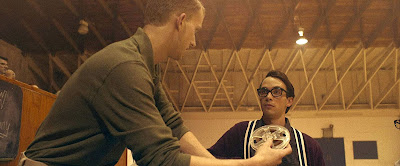Stage plays adapted to film can appear
static. Long scenes with people just sitting and talking can weary an
audience. Thus, filmmakers will sometimes try to liven up events by
breaking single location scenes into different locations, taking the
characters outdoors for a walk as they continue talking. Or they'll
have the camera roam for a bit, inserting a few brief action shots
for an interlude to break the monotony of all that talk.
The Vast of Night (2019) is a
talky film. Although its topic of alien abduction carries much
potential for action, it has many long, static scenes of people just
sitting and talking.
In one scene, Fay (Sierra McCormick) sits at
switchboard for ten minutes, listening to the radio or talking to
people over the phone. Ten minutes is a long time to focus on one
person just sitting in tight quarters, talking or listening.
It can be interesting, if
there's an engaging character in an intriguing situation. And Fay is
engaging. But however good the scene is, it might
be even better if things were livened up.
Director Andrew Patterson uses a mobile
camera and staging (actors walking or driving about for long
stretches) as active interludes between his long, static scenes.
Breaking up things before stupor sets into the audience.
The Vast of Night opens with a
long take, a mobile camera following Everett (Jake Horowitz) as he
enters a high school gym, walking about, talking to several people,
following a teacher downstairs to the basement, then up and out
again, into the parking lot.
Patterson uses several long takes for
this scene (some over two minutes in length) while a mobile camera
instills a sense of anticipation and excitement. Thus the film is
mostly a series of long, static scenes of people talking --
discussing aliens, government conspiracies, and lights in the sky --
interspersed with long interludes of the camera roaming about.
Sometimes Patterson's mobile camera follows
people. But sometimes it appears to be seeking something. In
which case, these mobile shots serve a secondary purpose.
At one point, the camera glides quickly
over the dark streets of this small New Mexico town, nobody in sight. Because of 1, the story's context, and 2, no human
is present, and 3, the camera moves faster than any human can run, it
feels as if we're seeing events from the POV of unearthly
being. An alien, perhaps? This appears not to be the case, but the
feeling is there nonetheless. And it adds to the film's eeriness.
=============
For more information on cinematography and staging in horror, see Horror Film Aesthetics: Creating the Visual Language of Fear. This blog represents a continuing discussion of my views on horror, picking up from where the book left off.


No comments:
Post a Comment